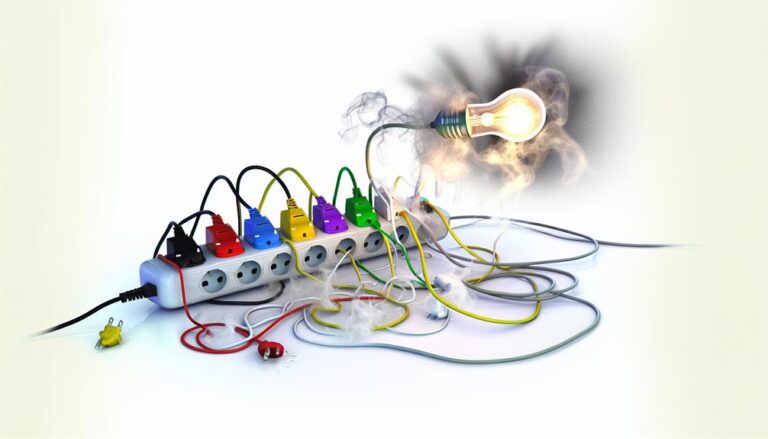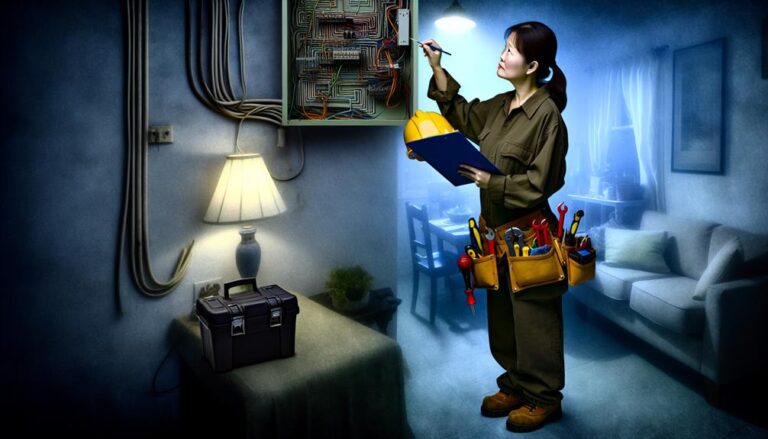The Role of Emergency Electricians in Natural Disasters
In the aftermath of a natural disaster, chaos reigns, and the world is plunged into darkness. Homes and businesses are left powerless, their inhabitants stranded in a state of uncertainty.
It is in these moments that emergency electricians emerge as beacons of hope, armed with their knowledge and expertise to restore light and bring solace to those affected.
But their role extends far beyond mere repair work. As you delve into the discussion ahead, you will discover the vital tasks and responsibilities that emergency electricians undertake to ensure the safety and recovery of communities devastated by natural disasters.
Key Takeaways
- Emergency electricians play a crucial role in assessing and repairing electrical damage caused by natural disasters.
- Safety precautions, such as turning off the main power supply and using personal protective equipment, are essential during emergency electrical work.
- Power restoration involves evaluating the extent of damage, repairing or replacing faulty equipment, and conducting thorough testing.
- Emergency electricians collaborate with other disaster recovery teams to coordinate efforts and provide technical expertise for efficient restoration.
Assessing Electrical Damage
To assess electrical damage in the aftermath of a natural disaster, you must carefully inspect all electrical systems and equipment for potential hazards or malfunctions. This is crucial to ensure the safety and functionality of your electrical infrastructure.
Start by turning off the main power supply to prevent any accidents or further damage. Then, conduct a thorough visual inspection of the entire system, looking for any signs of physical damage, such as frayed wires, exposed cables, or burnt components.
Check all circuit breakers, fuses, and surge protectors to make sure they’re intact and functioning properly. Test all outlets and switches to see if they’re working correctly. Use a multimeter to measure voltage levels and check for any abnormal readings.
Pay special attention to any water damage, as it can be a significant hazard. If you notice any signs of water infiltration, immediately disconnect the power and seek professional assistance.
Restoring Power to Affected Areas
After assessing the electrical damage caused by a natural disaster, the next step is to initiate the process of restoring power to the affected areas. This crucial task falls on the shoulders of emergency electricians, who play a vital role in bringing back electricity to communities in distress. To better understand the process, let’s examine the steps involved in restoring power:
| Steps | Description |
|---|---|
| Damage assessment | Electricians evaluate the extent of the electrical damage and identify areas that need immediate attention. |
| Safety measures | Before starting any restoration work, safety precautions are taken to protect both workers and residents. |
| Repairs and replacements | Faulty electrical equipment is repaired or replaced to ensure the safe and efficient flow of electricity. |
| Power restoration | Electricians work to reconnect power lines, restore electrical connections, and bring back electricity. |
| Testing and verification | After restoration, thorough testing is conducted to ensure that power is running smoothly and safely. |
Ensuring Safety During Emergencies
During emergencies, it’s crucial to prioritize safety measures to protect both workers and residents. The chaotic and unpredictable nature of natural disasters can expose individuals to various hazards, making safety precautions essential. As emergency electricians, your role in ensuring safety during emergencies is of utmost importance. Here are some crucial steps to follow:
- Evaluate the situation: Before performing any electrical work, assess the surrounding environment for potential dangers. Look out for fallen power lines, damaged electrical equipment, or gas leaks that could pose a threat to your safety and the safety of others.
- Use personal protective equipment (PPE): Always wear the appropriate PPE, including insulated gloves, safety glasses, and protective clothing. These items will shield you from electrical shocks, burns, and airborne debris.
- Secure the area: Establish a safety perimeter around the work area to prevent unauthorized personnel from entering. Use caution tape or barricades to ensure that only trained professionals have access to the site.
- Power off: Before working on any electrical system, ensure that the power source is turned off. This step eliminates the risk of electrocution and reduces the chance of electrical fires.
- Communicate effectively: Maintain clear and constant communication with your team members and emergency responders. This will help coordinate efforts, share information, and address any safety concerns promptly.
Repairing Electrical Infrastructure
When repairing electrical infrastructure in the aftermath of natural disasters, it’s crucial to address the damage caused by the emergency while ensuring the safety of both workers and residents. This process involves a series of meticulous steps to restore power and prevent further risks.
Here are some key actions taken during the repair of electrical infrastructure:
- Assessment and Planning: Electricians begin by assessing the extent of the damage, identifying areas that need immediate attention. They develop a comprehensive plan to prioritize repairs and ensure the efficient restoration of electricity.
- Safety Precautions: Before any work commences, electricians implement strict safety measures. They conduct thorough inspections to identify potential hazards, such as downed power lines or structural instability. Personal protective equipment (PPE) is worn by all workers to mitigate risks.
- Repair and Replacement: Electricians repair damaged electrical equipment and replace any components that are beyond repair. This may include fixing or replacing transformers, power lines, circuit breakers, and substations.
- Testing and Verification: After repairs are completed, electricians conduct rigorous testing to ensure that the electrical infrastructure is functioning properly. This includes testing voltage levels, circuit continuity, and overall system performance.
Supporting Disaster Recovery Efforts
To support disaster recovery efforts, electricians play a crucial role in restoring electrical infrastructure and ensuring the safe and efficient resumption of power.
In the aftermath of a natural disaster, such as a hurricane or earthquake, the electrical infrastructure is often severely damaged or completely destroyed. Electricians are responsible for assessing the extent of the damage and devising a plan to repair and restore the electrical systems. This includes repairing or replacing damaged power lines, transformers, and distribution equipment.
Electricians also play a vital role in ensuring the safety of the electrical systems during the recovery process. They conduct thorough inspections to identify any potential hazards, such as exposed wires or faulty equipment, which could pose a risk to both the public and the recovery workers. By addressing these hazards promptly, electricians help to prevent accidents and further damage to the electrical infrastructure.
Additionally, electricians work closely with other disaster recovery teams, such as emergency responders and utility workers, to coordinate efforts and prioritize areas that require immediate attention. They provide technical expertise and guidance to ensure that the restoration process is carried out efficiently and effectively.





